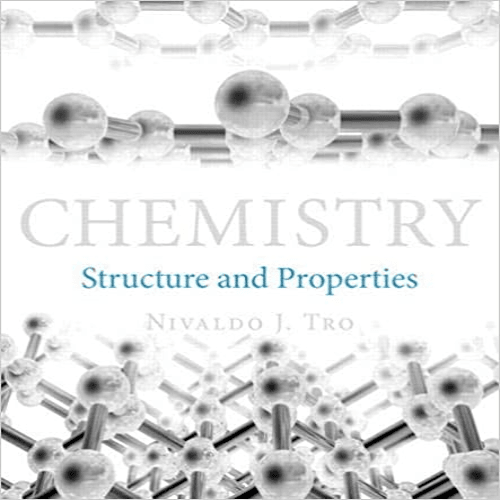Test Bank for Chemistry Structure and Properties 1st Edition by Tro ISBN 0321834682 9780321834683
$35.00 Original price was: $35.00.$26.50Current price is: $26.50.
Click Icon bellow to Download sample Chemistry Structure and Properties 1st Edition by Tro test bank 0321834682 9780321834683:
This is completed downloadable of Chemistry Structure and Properties 1st Edition by Nivaldo J. Tro Test Bank.

Instant download Chemistry Structure and Properties 1st Edition by Nivaldo J. Tro Test Bank pdf docx epub after payment.
Product Details:
Language: English
ISBN-10: 0321834682
ISBN-13: 978-0321834683
ISBN-13: 9780321834683
Author: Nivaldo J. Tro
Relate Product:
Table of Content:
1 Atoms
1.1 A Particulate View of the World: Structure Determines Properties
1.2 Classifying Matter: A Particulate View
1.3 The Scientific Approach to Knowledge
1.4 Early Ideas about the Building Blocks of Matter
1.5 Modern Atomic Theory and the Laws That Led to It
1.6 The Discovery of the Electron
1.7 The Structure of the Atom
1.8 Subatomic Particles: Protons, Neutrons, and Electrons
1.9 Atomic Mass: The Average Mass of an Element’s Atoms
1.10 The Origins of Atoms and Elements
2 Measurement, Problem Solving, and the Mole Concept
2.1 The Metric Mix-up: A $125 Million Unit Error
2.2 The Reliability of a Measurement
2.3 Density
2.4 Energy and Its Units
2.5 Converting between Units
2.6 Problem-Solving Strategies
2.7 Solving Problems Involving Equations
2.8 Atoms and the Mole: How Many Particles?
3 The Quantum-Mechanical Model of the Atom
3.1 Schrödinger’s Cat
3.2 The Nature of Light
3.3 Atomic Spectroscopy and the Bohr Model
3.4 The Wave Nature of Matter: The de Broglie Wavelength, the Uncertainty Principle, and Indeterminacy
3.5 Quantum Mechanics and the Atom
3.6 The Shapes of Atomic Orbitals
4 Periodic Properties of the Elements
4.1 Aluminum: Low-Density Atoms Result in Low-Density Metal
4.2 Finding Patterns: The Periodic Law and the Periodic Table
4.3 Electron Configurations: How Electrons Occupy Orbitals
4.4 Electron Configurations, Valence Electrons, and the Periodic Table
4.5 How the Electron Configuration of an Element Relates to Its Properties
4.6 Periodic Trends in the Size of Atoms and Effective Nuclear Charge
4.7 Ions: Electron Configurations, Magnetic Properties, Ionic Radii, and Ionization Energy
4.8 Electron Affinities and Metallic Character
5 Molecules and Compounds
5.1 Hydrogen, Oxygen, and Water
5.2 Types of Chemical Bonds
5.3 Representing Compounds: Chemical Formulas and Molecular Models
5.4 The Lewis Model: Representing Valence Electrons with Dots
5.5 Ionic Bonding: The Lewis Model and Lattice Energies
5.6 Ionic Compounds: Formulas and Names
5.7 Covalent Bonding: Simple Lewis Structures
5.8 Molecular Compounds: Formulas and Names
5.9 Formula Mass and the Mole Concept for Compounds
5.10 Composition of Compounds
5.11 Determining a Chemical Formula from Experimental Data
5.12 Organic Compounds
6 Chemical Bonding I: Drawing Lewis Structures and Determining Molecular Shapes
6.1 Morphine: A Molecular Imposter
6.2 Electronegativity and Bond Polarity
6.3 Writing Lewis Structures for Molecular Compounds and Polyatomic Ions
6.4 Resonance and Formal Charge
6.5 Exceptions to the Octet Rule: Odd-Electron Species, Incomplete Octets, and Expanded Octets
6.6 Bond Energies and Bond Lengths
6.7 VSEPR Theory: The Five Basic Shapes
6.8 VSEPR Theory: The Effect of Lone Pairs
6.9 VSEPR Theory: Predicting Molecular Geometries
6.10 Molecular Shape and Polarity
7 Chemical Bonding II: Valence Bond Theory and Molecular Orbital Theory
7.1 Oxygen: A Magnetic Liquid
7.2 Valence Bond Theory: Orbital Overlap as a Chemical Bond
7.3 Valence Bond Theory: Hybridization of Atomic Orbitals
7.4 Molecular Orbital Theory: Electron Delocalization
7.5 Molecular Orbital Theory: Polyatomic Molecules
7.6 Bonding in Metals and Semiconductors
8 Chemical Reactions and Chemical Quantities
8.1 Climate Change and the Combustion of Fossil Fuels
8.2 Chemical Change
8.3 Writing and Balancing Chemical Equations
8.4 Reaction Stoichiometry: How Much Carbon Dioxide?
8.5 Limiting Reactant, Theoretical Yield, and Percent Yield
8.6 Three Examples of Chemical Reactions: Combustion, Alkali Metals, and Halogens
9 Introduction to Solutions and Aqueous Reactions
9.1 Molecular Gastronomy
9.2 Solution Concentration
9.3 Solution Stoichiometry
9.4 Types of Aqueous Solutions and Solubility
9.5 Precipitation Reactions
9.6 Representing Aqueous Reactions: Molecular, Ionic, and Complete Ionic Equations
9.7 Acid–Base Reactions
9.8 Gas-Evolution Reactions
9.9 Oxidation–Reduction Reactions
10 Thermochemistry
10.1 On Fire, But Not Consumed
10.2 The Nature of Energy: Key Definitions
10.3 The First Law of Thermodynamics: There Is No Free Lunch
10.4 Quantifying Heat and Work
10.5 Measuring ΔE for Chemical Reactions: Constant-Volume Calorimetry
10.6 Enthalpy: The Heat Evolved in a Chemical Reaction at Constant Pressure
10.7 Measuring ΔH for Chemical Reactions: Constant-Pressure Calorimetry
10.8 Relationships Involving ΔHrxn
10.9 Determining Enthalpies of Reaction from Bond Energies
10.10 Determining Enthalpies of Reaction from Standard Enthalpies of Formation
10.11 Lattice Energies for Ionic Compounds
11 Gases
11.1 Supersonic Skydiving and the Risk of Decompression
11.2 Pressure: The Result of Particle Collisions
11.3 The Simple Gas Laws: Boyle’s Law, Charles’s Law, and Avogadro’s Law
11.4 The Ideal Gas Law
11.5 Applications of the Ideal Gas Law: Molar Volume, Density, and Molar Mass of a Gas
11.6 Mixtures of Gases and Partial Pressures
11.7 A Particulate Model for Gases: Kinetic Molecular Theory
11.8 Temperature and Molecular Velocities
11.9 Mean Free Path, Diffusion, and Effusion of Gases
11.10 Gases in Chemical Reactions: Stoichiometry Revisited
11.11 Real Gases: The Effects of Size and Intermolecular Forces
12 Liquids, Solids, and Intermolecular Forces
12.1 Structure Determines Properties
12.2 Solids, Liquids, and Gases: A Molecular Comparison
12.3 Intermolecular Forces: The Forces That Hold Condensed States Together
12.4 Intermolecular Forces in Action: Surface Tension, Viscosity, and Capillary Action
12.5 Vaporization and Vapor Pressure
12.6 Sublimation and Fusion
12.7 Heating Curve for Water
12.8 Water: An Extraordinary Substance
13 Phase Diagrams and Crystalline Solids
13.1 Sliding Glaciers
13.2 Phase Diagrams
13.3 Crystalline Solids: Determining Their Structure by X-Ray Crystallography
13.4 Crystalline Solids: Unit Cells and Basic Structures
13.5 Crystalline Solids: The Fundamental Types
13.6 The Structures of Ionic Solids
13.7 Network Covalent Atomic Solids: Carbon and Silicates
14 Solutions
14.1 Antifreeze in Frogs
14.2 Types of Solutions and Solubility
14.3 Energetics of Solution Formation
14.4 Solution Equilibrium and Factors Affecting Solubility
14.5 Expressing Solution Concentration
14.6 Colligative Properties: Vapor Pressure Lowering, Freezing Point Depression, Boiling Point Elevation, and Osmotic Pressure
14.7 Colligative Properties of Strong Electrolyte Solutions
15 Chemical Kinetics
15.1 Catching Lizards
15.2 Rates of Reaction and the Particulate Nature of Matter
15.3 Defining and Measuring the Rate of a Chemical Reaction
15.4 The Rate Law: The Effect of Concentration on Reaction Rate
15.5 The Integrated Rate Law: The Dependence of Concentration on Time
15.6 The Effect of Temperature on Reaction Rate
15.7 Reaction Mechanisms
15.8 Catalysis
16 Chemical Equilibrium
16.1 Fetal Hemoglobin and Equilibrium
16.2 The Concept of Dynamic Equilibrium
16.3 The Equilibrium Constant (K)
16.4 Expressing the Equilibrium Constant in Terms of Pressure
16.5 Heterogeneous Equilibria: Reactions Involving Solids and Liquids
16.6 Calculating the Equilibrium Constant from Measured Equilibrium Concentrations
16.7 The Reaction Quotient: Predicting the Direction of Change
16.8 Finding Equilibrium Concentrations
16.9 Le Châtelier’s Principle: How a System at Equilibrium Responds to Disturbances
17 Acids and Bases
17.1 Batman’s Basic Blunder
17.2 The Nature of Acids and Bases
17.3 Definitions of Acids and Bases
17.4 Acid Strength and Molecular Structure
17.5 Acid Strength and the Acid Ionization Constant (Ka)
17.6 Autoionization of Water and pH
17.7 Finding the [H3O+] and pH of Strong and Weak Acid Solutions
17.8 Finding the [OH-] and pH of Strong and Weak Base Solutions
17.9 The Acid–Base Properties of Ions and Salts
17.10 Polyprotic Acids
17.11 Lewis Acids and Bases
18 Aqueous Ionic Equilibrium
18.1 The Danger of Antifreeze
18.2 Buffers: Solutions That Resist pH Change
18.3 Buffer Effectiveness: Buffer Range and Buffer Capacity
18.4 Titrations and pH Curves
18.5 Solubility Equilibria and the Solubility Product Constant
18.6 Precipitation
18.7 Complex Ion Equilibria
19 Free Energy and Thermodynamics
19.1 Energy Spreads Out
19.2 Spontaneous and Nonspontaneous Processes
19.3 Entropy and the Second Law of Thermodynamics
19.4 Predicting Entropy and Entropy Changes for Chemical Reactions
19.5 Heat Transfer and Entropy Changes of the Surroundings
19.6 Gibbs Free Energy
19.7 Free Energy Changes in Chemical Reactions: Calculating
19.8 Free Energy Changes for Nonstandard States: The Relationship between and
19.9 Free Energy and Equilibrium: Relating to the Equilibrium Constant (K)
20 Electrochemistry
20.1 Lightning and Batteries
20.2 Balancing Oxidation–Reduction Equations
20.3 Voltaic (or Galvanic) Cells: Generating Electricity from Spontaneous Chemical Reactions
20.4 Standard Electrode Potentials
20.5 Cell Potential, Free Energy, and the Equilibrium Constant
20.6 Cell Potential and Concentration
20.7 Batteries: Using Chemistry to Generate Electricity
20.8 Electrolysis: Driving Nonspontaneous Chemical Reactions with Electricity
20.9 Corrosion: Undesirable Redox Reactions
21 Radioactivity and Nuclear Chemistry
21.1 Diagnosing Appendicitis
21.2 The Discovery of Radioactivity
21.3 Types of Radioactivity
21.4 The Valley of Stability: Predicting the Type of Radioactivity
21.5 Detecting Radioactivity
21.6 The Kinetics of Radioactive Decay and Radiometric Dating
21.7 The Discovery of Fission: The Atomic Bomb and Nuclear Power
21.8 Converting Mass to Energy: Mass Defect and Nuclear Binding Energy
21.9 Nuclear Fusion: The Power of the Sun
21.10 Nuclear Transmutation and Transuranium Elements
21.11 The Effects of Radiation on Life
21.12 Radioactivity in Medicine and Other Applications
22 Organic Chemistry
22.1 Fragrances and Odors
22.2 Carbon: Why It Is Unique
22.3 Hydrocarbons: Compounds Containing Only Carbon and Hydrogen
22.4 Alkanes: Saturated Hydrocarbons
22.5 Alkenes and Alkynes
22.6 Hydrocarbon Reactions
22.7 Aromatic Hydrocarbons
22.8 Functional Groups
22.9 Alcohols
22.10 Aldehydes and Ketones
22.11 Carboxylic Acids and Esters
22.12 Ethers
22.13 Amines
22.14 Polymers
23 Transition Metals and Coordination Compounds
23.1 The Colors of Rubies and Emeralds
23.2 Properties of Transition Metals
23.3 Coordination Compounds
23.4 Structure and Isomerization
23.5 Bonding in Coordination Compounds
23.6 Applications of Coordination Compounds
People Also Search:
chemistry structure and properties 1st edition pdf free download
chemistry structure and properties 1st edition pdf
chemistry structure and properties by tro 1st edition
Chemistry Structure and Properties 1st Edition by Tro test bank download free
download test bank for Chemistry Structure and Properties 1st Edition by Tro





